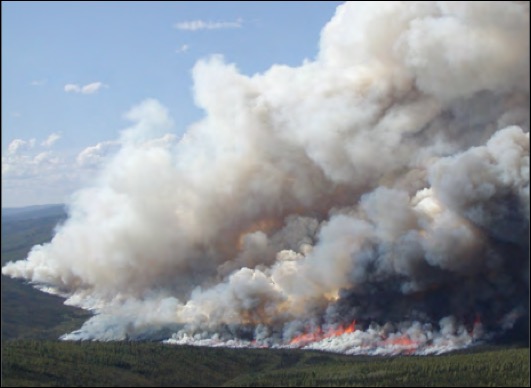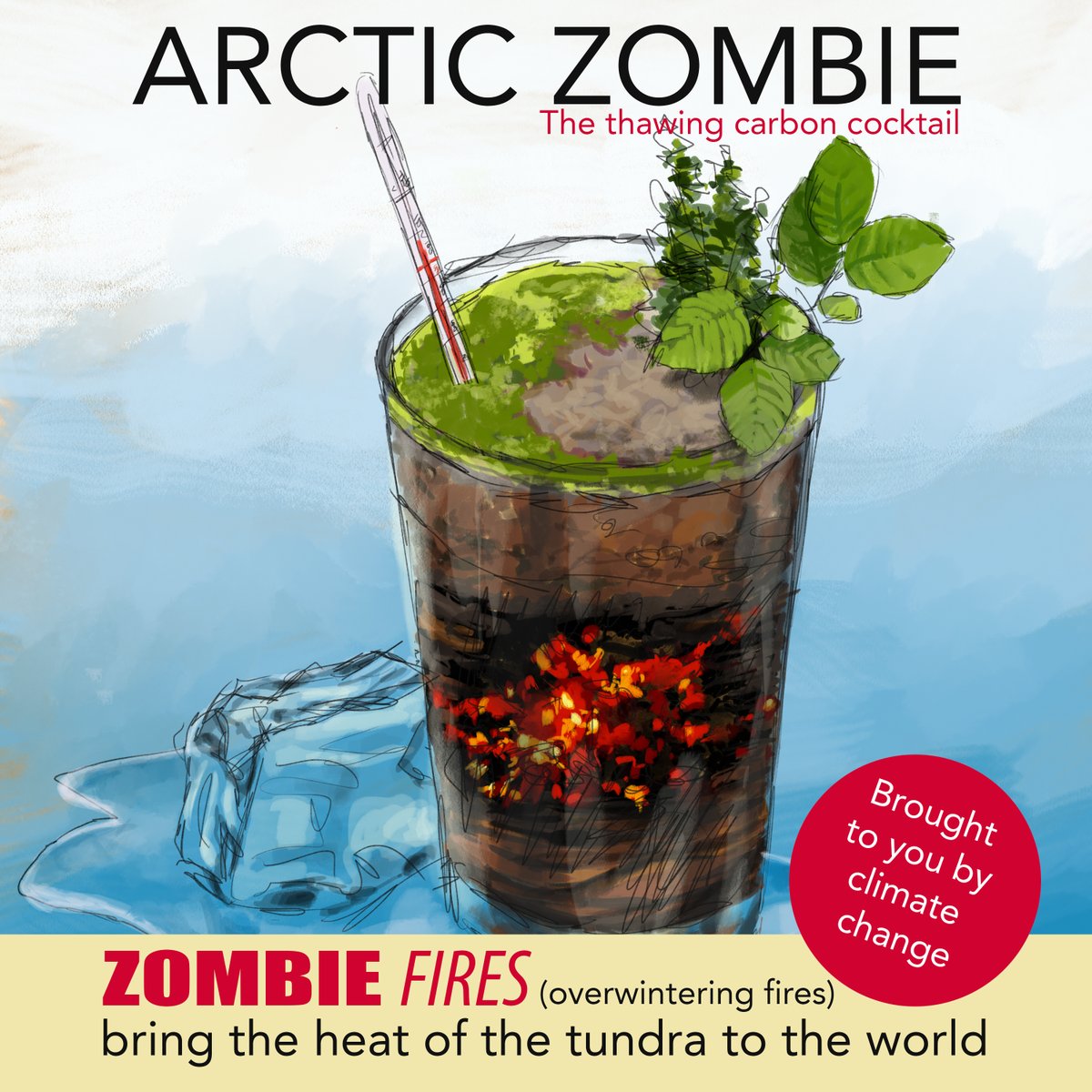we outline a call to action. Key messages - 1) a global climate problem requires a global scale solution, 2) western science can& #39;t tackle this without Indigenous knowlege holders. w/ @jmccarty_geo @DrTELS https://instaar.colorado.edu/news-events/instaar-news/arctic-is-burning-in-a-whole-new-way/">https://instaar.colorado.edu/news-even...
2/ Will Arctic  https://abs.twimg.com/emoji/v2/... draggable="false" alt="🔥" title="Feuer" aria-label="Emoji: Feuer"> burn into ancient carbon stored in peat & permafrost? We conclude that the 2020 fires in Siberia showed signs of holdover or zombie fires, which can overwinter in deep peat & influence burning the following season. This represents momentum in the climate system.
https://abs.twimg.com/emoji/v2/... draggable="false" alt="🔥" title="Feuer" aria-label="Emoji: Feuer"> burn into ancient carbon stored in peat & permafrost? We conclude that the 2020 fires in Siberia showed signs of holdover or zombie fires, which can overwinter in deep peat & influence burning the following season. This represents momentum in the climate system.
3/ Scientists have long debated the use of the term zombie fire, but also the importance of these holdover conditions. How important are they? Moving from anecdotal to monitoring will require collaborating with local knowledge holders. https://www.ilinationhood.ca/our-work/guardians/">https://www.ilinationhood.ca/our-work/...
4/  https://abs.twimg.com/emoji/v2/... draggable="false" alt="🔥" title="Feuer" aria-label="Emoji: Feuer"> in Siberia is affecting ecosystems we typically regard as fire resistant. This is also happening in the boreal biome - systems used as fire breaks are becoming fire problems. These also tend to be the hot spots of peat carbon accumulation in these landscapes.
https://abs.twimg.com/emoji/v2/... draggable="false" alt="🔥" title="Feuer" aria-label="Emoji: Feuer"> in Siberia is affecting ecosystems we typically regard as fire resistant. This is also happening in the boreal biome - systems used as fire breaks are becoming fire problems. These also tend to be the hot spots of peat carbon accumulation in these landscapes.
5/ I love to tweet about peat, but I also love permafrost. In our paper, @DrTELS concluded that most of the Siberian fires occurred in the most sensitive type of permafrost to abrupt thawing or thermokarst. We describe this process in more detail here. https://www.nature.com/articles/d41586-019-01313-4">https://www.nature.com/articles/...
6/ What is the role of Arctic  https://abs.twimg.com/emoji/v2/... draggable="false" alt="🔥" title="Feuer" aria-label="Emoji: Feuer"> in the potential carbon cocktail of permafrost thaw and landscape change? With temps >100 degF this summer and massive craters opening up due to thaw, fire is an additional hazard that can accelerate thawing ground.
https://abs.twimg.com/emoji/v2/... draggable="false" alt="🔥" title="Feuer" aria-label="Emoji: Feuer"> in the potential carbon cocktail of permafrost thaw and landscape change? With temps >100 degF this summer and massive craters opening up due to thaw, fire is an additional hazard that can accelerate thawing ground.

 Read on Twitter
Read on Twitter is now shaping the Arctic. In @NatureGeosciwe outline a call to action. Key messages - 1) a global climate problem requires a global scale solution, 2) western science can& #39;t tackle this without Indigenous knowlege holders. w/ @jmccarty_geo @DrTELS https://instaar.colorado.edu/news-even..." title="https://abs.twimg.com/emoji/v2/... draggable="false" alt="🔥" title="Feuer" aria-label="Emoji: Feuer">is now shaping the Arctic. In @NatureGeosciwe outline a call to action. Key messages - 1) a global climate problem requires a global scale solution, 2) western science can& #39;t tackle this without Indigenous knowlege holders. w/ @jmccarty_geo @DrTELS https://instaar.colorado.edu/news-even..." class="img-responsive" style="max-width:100%;"/>
is now shaping the Arctic. In @NatureGeosciwe outline a call to action. Key messages - 1) a global climate problem requires a global scale solution, 2) western science can& #39;t tackle this without Indigenous knowlege holders. w/ @jmccarty_geo @DrTELS https://instaar.colorado.edu/news-even..." title="https://abs.twimg.com/emoji/v2/... draggable="false" alt="🔥" title="Feuer" aria-label="Emoji: Feuer">is now shaping the Arctic. In @NatureGeosciwe outline a call to action. Key messages - 1) a global climate problem requires a global scale solution, 2) western science can& #39;t tackle this without Indigenous knowlege holders. w/ @jmccarty_geo @DrTELS https://instaar.colorado.edu/news-even..." class="img-responsive" style="max-width:100%;"/>
 burn into ancient carbon stored in peat & permafrost? We conclude that the 2020 fires in Siberia showed signs of holdover or zombie fires, which can overwinter in deep peat & influence burning the following season. This represents momentum in the climate system." title="2/ Will Arctic https://abs.twimg.com/emoji/v2/... draggable="false" alt="🔥" title="Feuer" aria-label="Emoji: Feuer"> burn into ancient carbon stored in peat & permafrost? We conclude that the 2020 fires in Siberia showed signs of holdover or zombie fires, which can overwinter in deep peat & influence burning the following season. This represents momentum in the climate system." class="img-responsive" style="max-width:100%;"/>
burn into ancient carbon stored in peat & permafrost? We conclude that the 2020 fires in Siberia showed signs of holdover or zombie fires, which can overwinter in deep peat & influence burning the following season. This represents momentum in the climate system." title="2/ Will Arctic https://abs.twimg.com/emoji/v2/... draggable="false" alt="🔥" title="Feuer" aria-label="Emoji: Feuer"> burn into ancient carbon stored in peat & permafrost? We conclude that the 2020 fires in Siberia showed signs of holdover or zombie fires, which can overwinter in deep peat & influence burning the following season. This represents momentum in the climate system." class="img-responsive" style="max-width:100%;"/>
 in Siberia is affecting ecosystems we typically regard as fire resistant. This is also happening in the boreal biome - systems used as fire breaks are becoming fire problems. These also tend to be the hot spots of peat carbon accumulation in these landscapes." title="4/ https://abs.twimg.com/emoji/v2/... draggable="false" alt="🔥" title="Feuer" aria-label="Emoji: Feuer"> in Siberia is affecting ecosystems we typically regard as fire resistant. This is also happening in the boreal biome - systems used as fire breaks are becoming fire problems. These also tend to be the hot spots of peat carbon accumulation in these landscapes." class="img-responsive" style="max-width:100%;"/>
in Siberia is affecting ecosystems we typically regard as fire resistant. This is also happening in the boreal biome - systems used as fire breaks are becoming fire problems. These also tend to be the hot spots of peat carbon accumulation in these landscapes." title="4/ https://abs.twimg.com/emoji/v2/... draggable="false" alt="🔥" title="Feuer" aria-label="Emoji: Feuer"> in Siberia is affecting ecosystems we typically regard as fire resistant. This is also happening in the boreal biome - systems used as fire breaks are becoming fire problems. These also tend to be the hot spots of peat carbon accumulation in these landscapes." class="img-responsive" style="max-width:100%;"/>
 in the potential carbon cocktail of permafrost thaw and landscape change? With temps >100 degF this summer and massive craters opening up due to thaw, fire is an additional hazard that can accelerate thawing ground." title="6/ What is the role of Arctic https://abs.twimg.com/emoji/v2/... draggable="false" alt="🔥" title="Feuer" aria-label="Emoji: Feuer"> in the potential carbon cocktail of permafrost thaw and landscape change? With temps >100 degF this summer and massive craters opening up due to thaw, fire is an additional hazard that can accelerate thawing ground." class="img-responsive" style="max-width:100%;"/>
in the potential carbon cocktail of permafrost thaw and landscape change? With temps >100 degF this summer and massive craters opening up due to thaw, fire is an additional hazard that can accelerate thawing ground." title="6/ What is the role of Arctic https://abs.twimg.com/emoji/v2/... draggable="false" alt="🔥" title="Feuer" aria-label="Emoji: Feuer"> in the potential carbon cocktail of permafrost thaw and landscape change? With temps >100 degF this summer and massive craters opening up due to thaw, fire is an additional hazard that can accelerate thawing ground." class="img-responsive" style="max-width:100%;"/>


